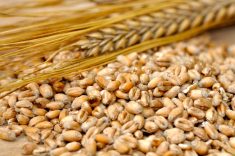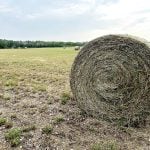MarketsFarm — Production of most of Canada’s major grain, oilseed and pulse crops was down substantially in 2021-22, as drought conditions across the Prairies cut into yields, according to preliminary estimates released Monday by Statistics Canada.
Of the major crops, only corn was expected to see a slight increase in production on the year as conditions were more favourable in Ontario, where the bulk of the crop is grown.
“Farmers across Western Canada have had to contend with a lack of rain and higher-than-average temperatures throughout the growing season,” StatsCan said.
Read Also

U.S. grains: Soybeans tumble on doubts over U.S.-China trade progress
Chicago Board of Trade soybean futures plummeted on Friday as trade restrictions announced by China and escalating rhetoric from U.S. President Donald Trump cooled hopes of a resolution to a standoff between Washington and Beijing.
“This has exacerbated soil moisture conditions, which were already low at the start of the year. These factors have negatively impacted crop growth and yield potential across much of the Prairies.”
Canadian wheat production was estimated at 22.9 million tonnes, which would be down 34.8 per cent from the 35.2 million tonnes grown the previous year. Of that total, durum production was down 39.2 per cent on the year at an estimated four million tonnes. Both were in line with pre-report trade expectations.
Canola production is forecast to come in at its lowest level since 2012, at 14.7 million tonnes. That was in line with expectations and compares with the upwardly-revised 19.5 million tonnes grown in 2020-21.
“Canada has a herculean rationing job ahead on all of these commodities,” MarketsFarm Pro analyst Mike Jubinville said.
That doesn’t mean that prices need to rise every day, he said — but it does mean Canadian prices will need to trade at premium levels in order to discourage demand.
Actual production was likely smaller than these estimates, he said, given the satellite imagery methodology used.
“Even though the sophistication of the satellite imagery is getting better every year, it doesn’t address the amount of acres abandoned… and it doesn’t capture the degree of the crops that didn’t properly fill.”
Barley and oats, at 7.8 million and 3.1 million tonnes respectively, were down by 27 and 20 per cent respectively on the year.
Among pulse crops, pea production is estimated to be down 43 per cent from 2020-21 at 2.6 million tonnes. Lentils, at two million tonnes, were down by 31 per cent.
Meanwhile, corn production was up by 0.8 per cent at 13.7 million tonnes, with the bulk of the crop grown in Ontario. Soybeans, at 5.8 million tonnes, were down by 8.4 per cent on the year.
Satellite imagery and historical modeling were used to compile the numbers, with the final survey-based estimates set for release on Dec. 3.
Table: A quick summary of Statistics Canada’s August principal field crop production estimates for 2021-22, with trade estimates and year-ago numbers included for comparison. Production in millions of metric tonnes. Source: Statistics Canada.
| Pre-report | |||
| trade estimates, . | August | ||
| 2021-22 | 2021-22. . | 2020-21 | |
| All wheat | 18.900 – 25.400 | 22.948 | 35.183 |
| – Durum | 3.300 – 5.400 | 3.998 | 6.571 |
| Oats | 2.500 – 3.300 | 3.070 | 4.576 |
| Barley | 6.500 – 10.100 | 7.836 | 10.741 |
| Canola | 11.500 – 16.000 | 14.749 | 19.485 |
| Grain corn. . | n/a | 13.677 | 13.563 |
| Soybeans | n/a | 5.823 | 6.359 |
| Peas | 2.500 – 3.800 | 2.627 | 4.594 |
| Lentils | 1.800 – 2.600 | 1.979 | 2.868 |














